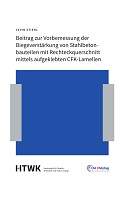Beitrag zur Vorbemessung der Biegeverstärkung von Stahlbetonbauteilen mit Rechteckquerschnitt mittels aufgeklebten CFK-Lamellen
Abstract
"Since 2012, the subsequent reinforcement of reinforced concrete components with bonded reinforcement has been regulated in a separate guideline. This includes the dimensioning of the adhesively bonded strips made of carbon fiber reinforced plastic (CFRP), which, in addition to the complex iterative bending design, have a very complex bonding behavior. For this purpose, the German Committee for Structural Concrete developed a model for the verification based on experimental evaluations, in which the occurring tensile forces are partly transferred into the component via intermediate elements (partial distances between flexural cracks). Simultaneously, simplified but more inaccurate verification formats were made available to reduce the complexity of the verification. For an early assessment of the use of bonded CFRP strips, different tools have been developed in this paper for reinforced concrete components with a rectangular cross-section depending on the different verification formats. For this purpose, the design parameters were
considered separately for pure bending strength and bonding behavior. For a simple calculation, tables for the design with dimensionless coefficients were obtained by analogy with the reinforced concrete construction, with which the required cross-section area for the CFRP strips can be determined by means of a limited stretching from the simplified verification of the flexural load bearing capacity. For a more economical solution, the more precise verification of the force transmission on the intermediate elements was configured in an Excel workbook, because this results in an extraordinary iterative calculation effort." Das nachträgliche Verstärken von Stahlbetonbauteilen mit geklebter Bewehrung ist seit 2012 in einer eigenen Richtlinie geregelt. Darin sind u.a. die erforderlichen Nachweise für aufgeklebte Lamellen aus kohlenstofffaserverstärktem Kunststoff (CFK) geregelt, welche neben der aufwendigen iterativen Biegebemessung ein sehr komplexes Verbundverhalten aufweisen. Dafür wurde vom Deutschen Ausschuss für Stahlbeton anhand von Versuchsauswertungen ein Modell zur Nachweisführung erarbeitet, wobei die auftretenden Zugkräfte zum Teil über Zwischenrisselemente (Teilstrecken zwischen Biegerissen) in das Bauteil übertragen werden. Aufgrund des Umfangs und der Komplexität der Nachweisführung wurden gleichzeitig vereinfachte, aber ungenauere Nachweisformate darin zur Verfügung gestellt. Um eine frühzeitige Abschätzung über den Einsatz von aufgeklebten CFK-Lamellen zu ermöglichen, wurden in dieser Arbeit unterschiedliche Hilfsmittel für Stahlbetonbauteile mit Rechteckquerschnitt in Abhängigkeit der unterschiedlichen Nachweisformate erarbeitet. Dazu wurden die Bemessungsgrundlagen getrennt nach reiner Biegetragfähigkeit und dem Verbundverhalten betrachtet. Für eine einfache Handrechnung ergaben sich analog zum Stahlbetonbau Bemessungstafeln mit dimensionslosen Beiwerten mit denen anhand einer Grenzdehnung aus dem vereinfachten Nachweis der Biegetragfähigkeit die erforderliche Lamellenfläche bestimmt werden kann. Für eine wirtschaftlichere Lösung wurde der genauere Nachweis der Lamellenkraftänderung am Zwischenrisselement in einer Excel-Arbeitsmappe konfiguriert, da hierbei ein außerordentlicher iterativer Berechnungsaufwand entsteht.
Keywords
Open Access; monograph; HTWK Leipzig; OA-HVerlag; bachelor thesis; reinforced concrete; carbon fiber; CFRP; bending strength; flexural load; concrete; Bachelorarbeit; Stahlbetonbau; CFK; Biegetragfähigkeit; Biegeverstärkung; Stahlbeton; BetonDOI
10.33968/9783966270021-00ISBN
9783966270038; 9783966270007; 9783966270014, 9783966270069, 9783966270038Publisher
HTWK Leipzig - OA-HochschulverlagPublisher website
https://oa-hochschulverlag.htwk-leipzig.de/mainnavigation/Publication date and place
Leipzig, 2020Classification
Electronics and communications engineering


 Download
Download Download
Download